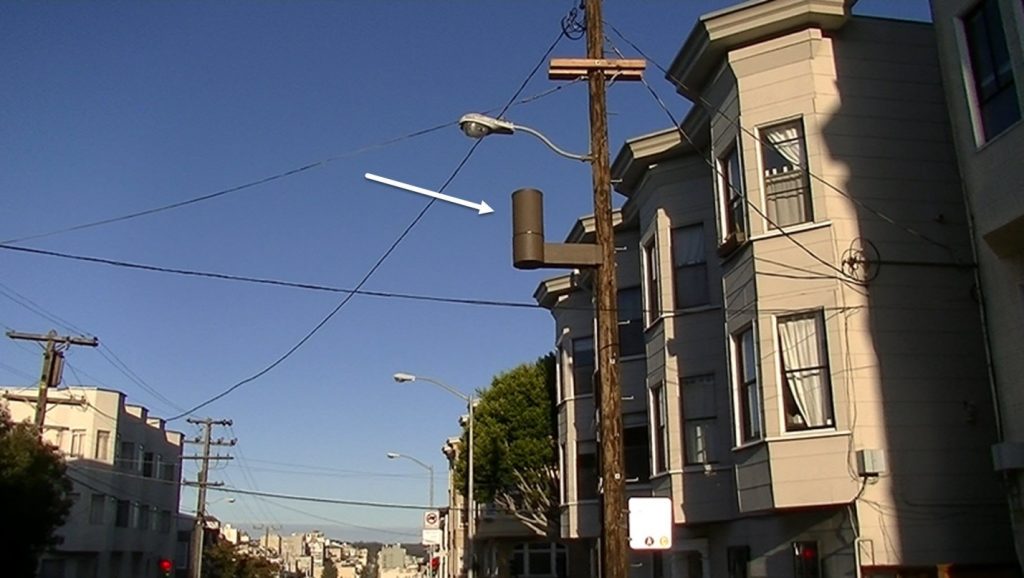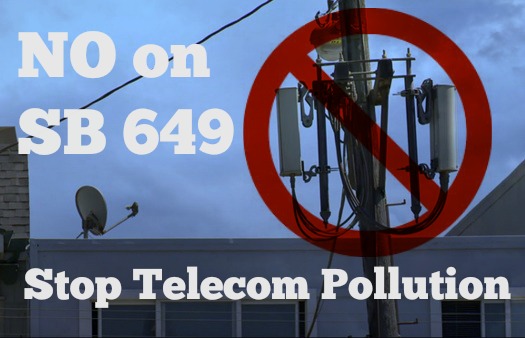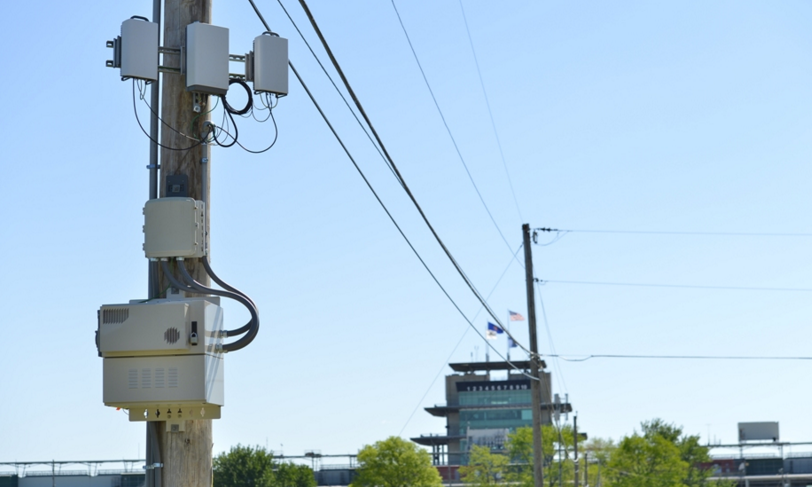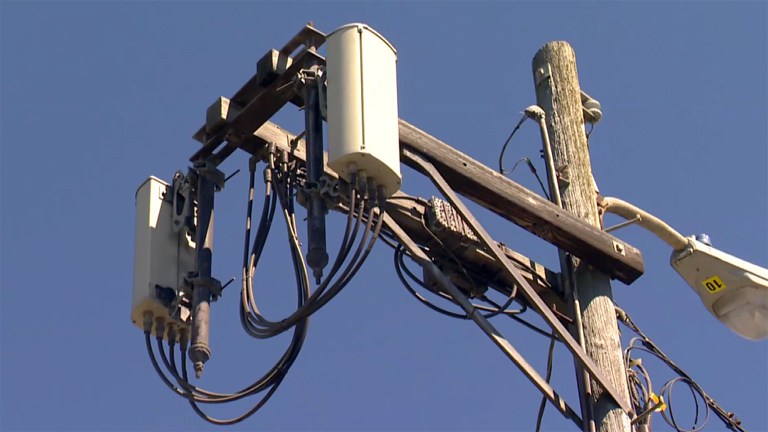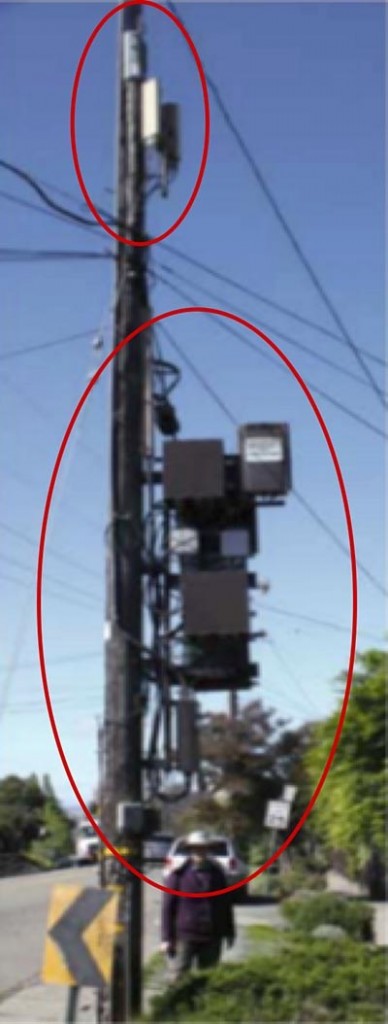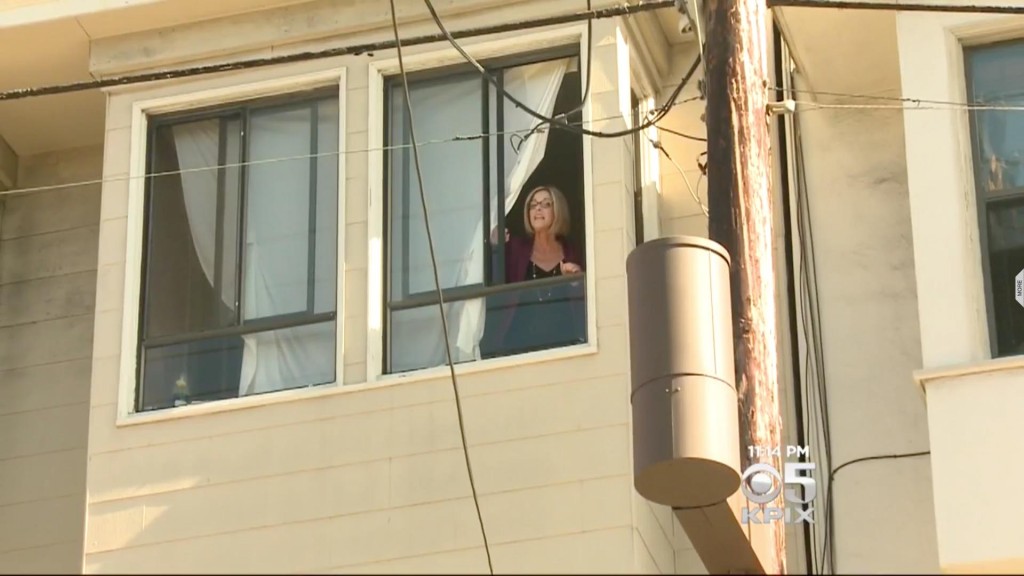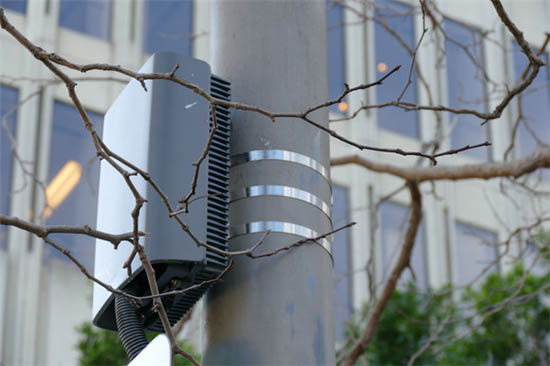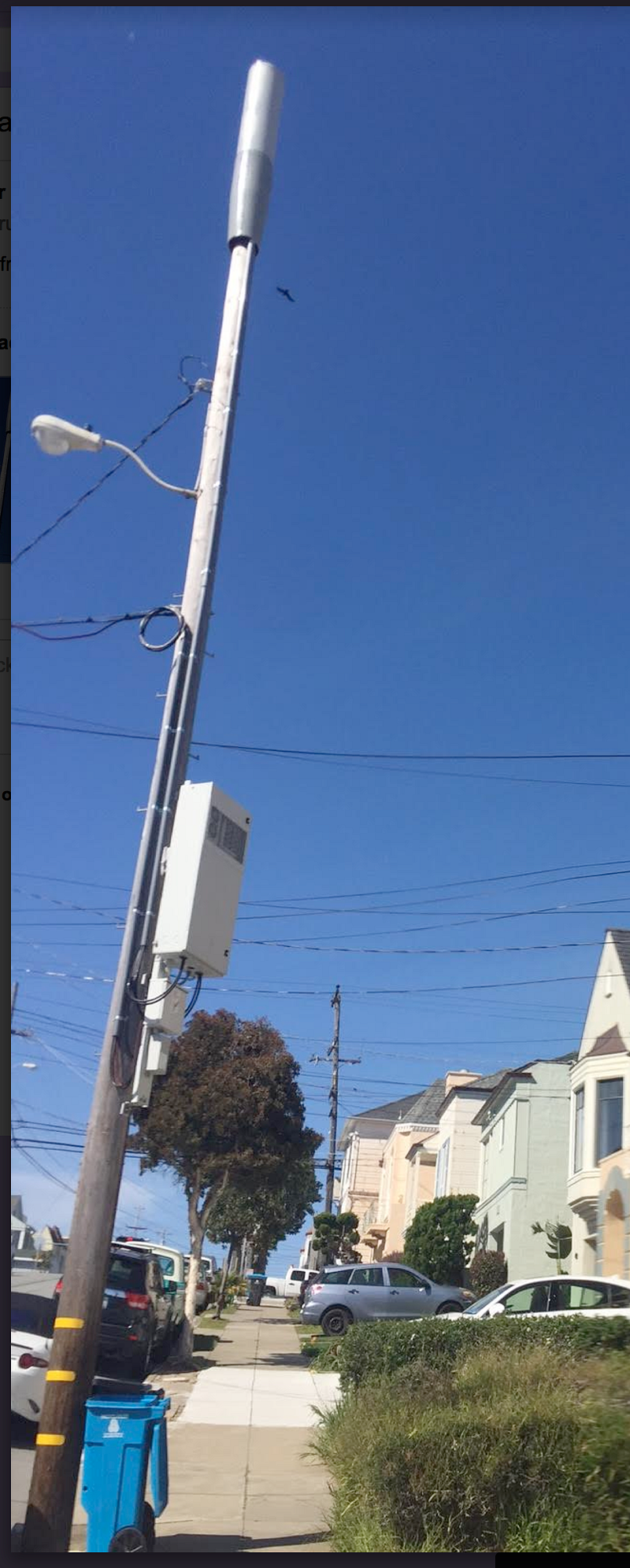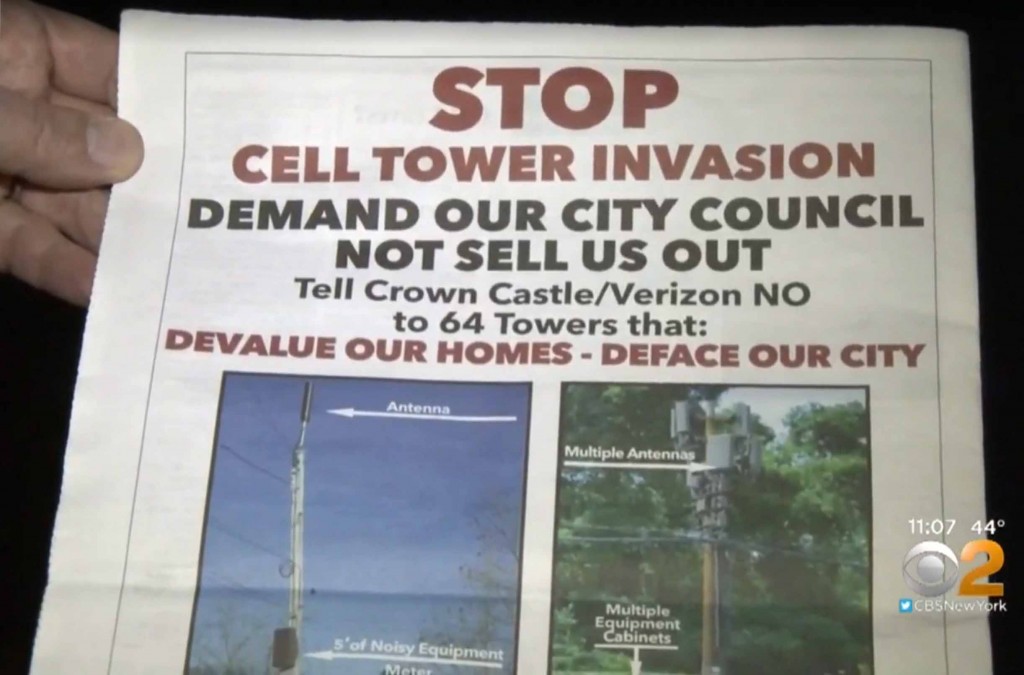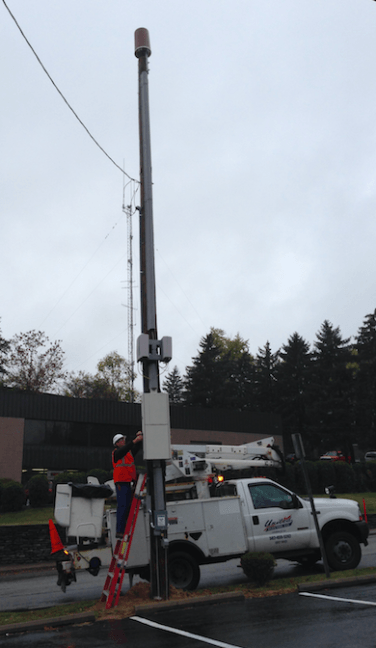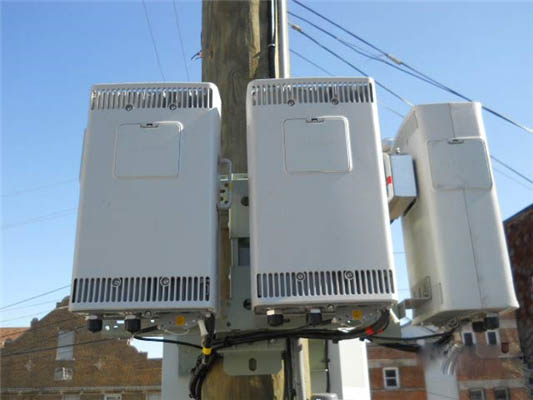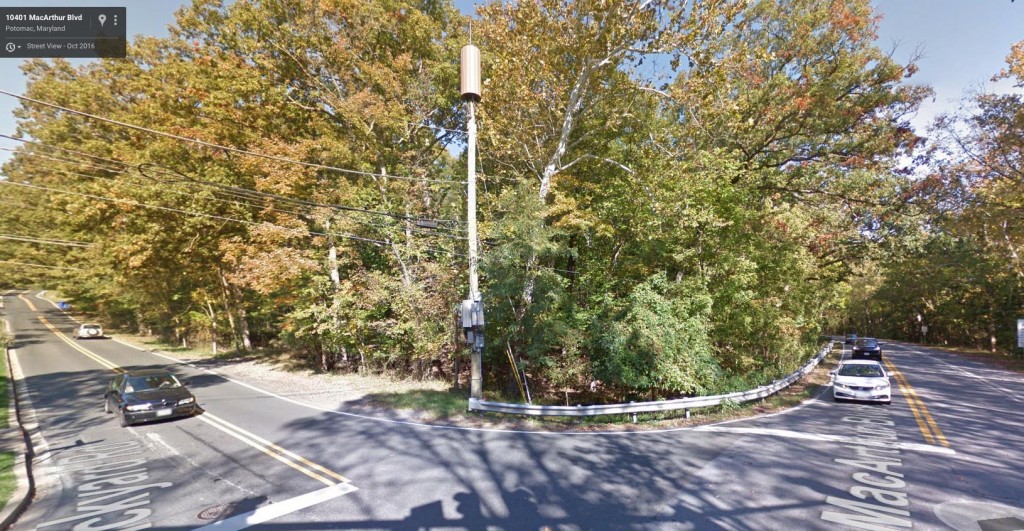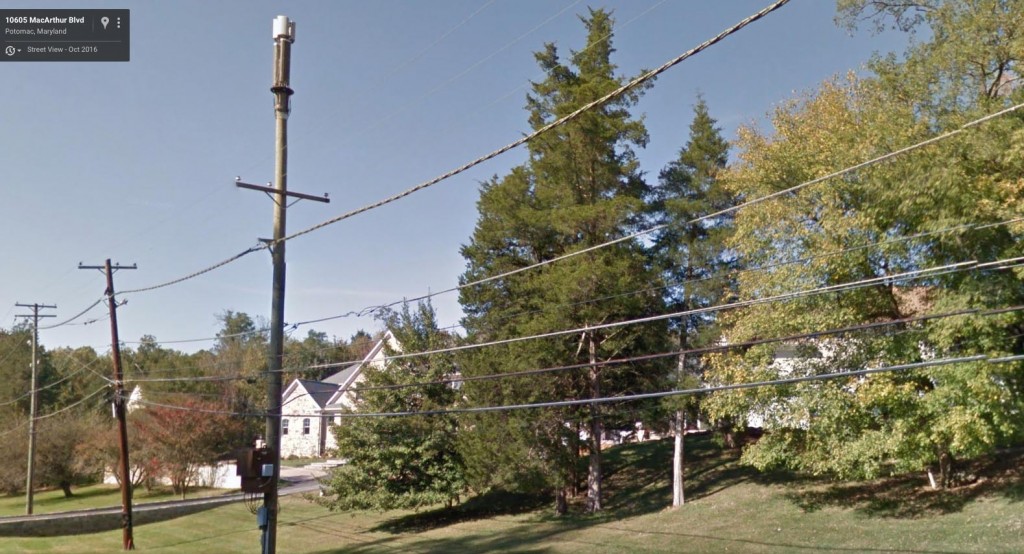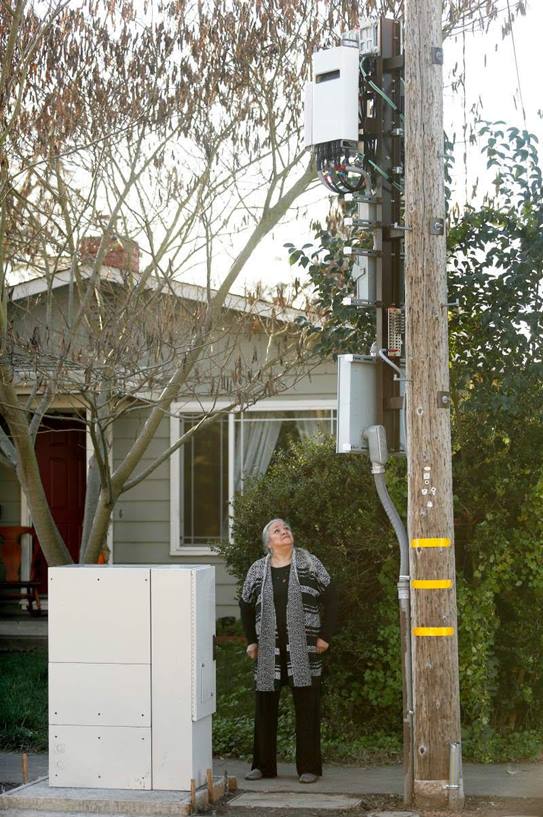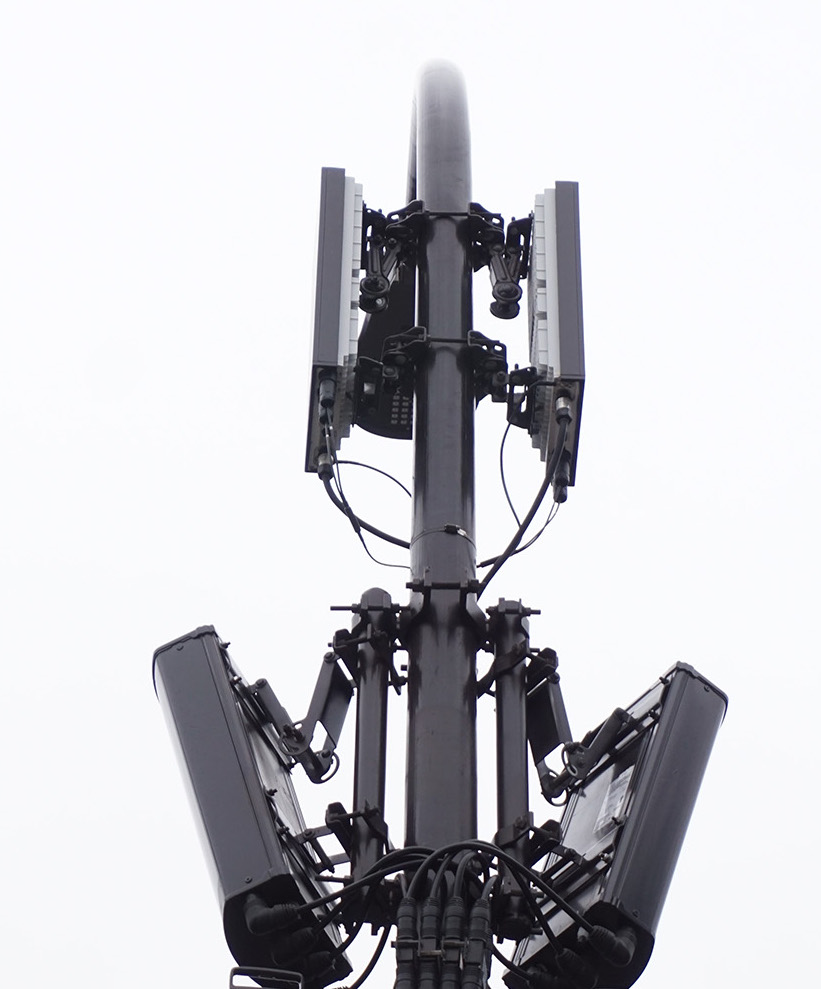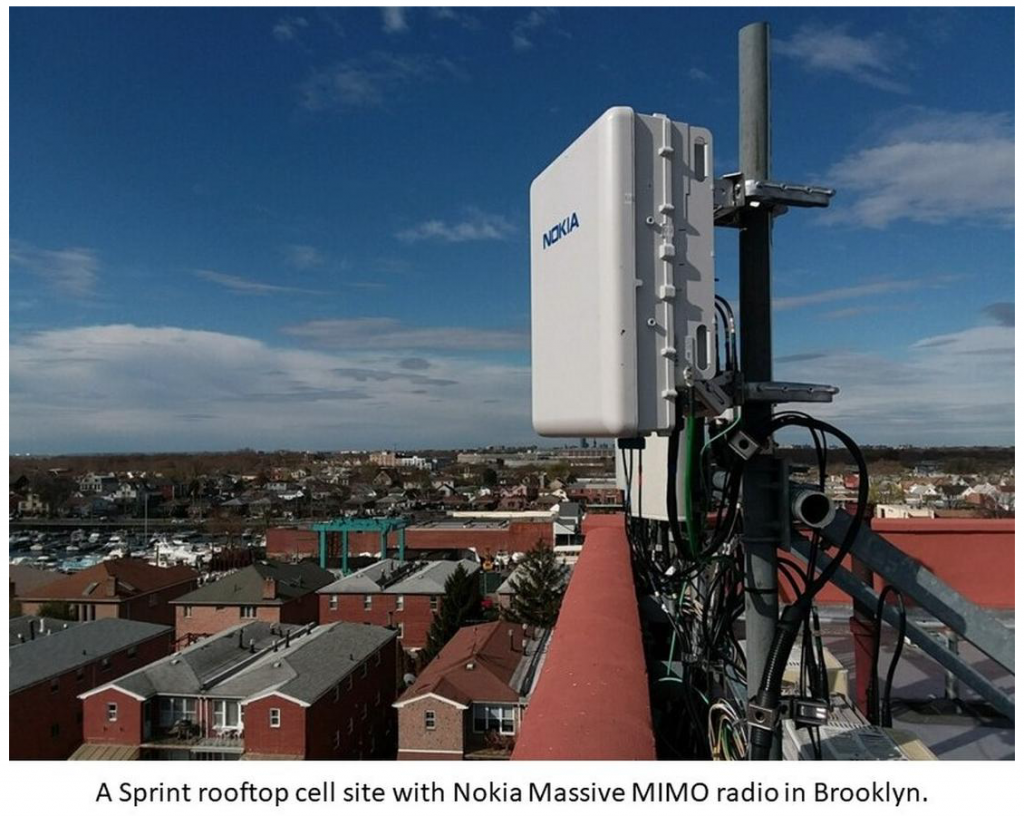“Twenty state legislatures—Arizona, Colorado, Delaware, Florida, Hawaii, Illinois, Indiana, Iowa, Kansas, Minnesota, Missouri, North Carolina, New Mexico, Ohio, Oklahoma, Rhode Island, Tennessee, Texas, Utah, and Virginia—have enacted small cell legislation that streamlines regulations to facilitate the deployment of 5G small cells.”
https://mdsafetech.org/expert-letters-california-sb649-small-cell-antenna-deployment/
••••••••••••••••••••••••••••••••••••••••••••••••••••••••••••••••••••••••••••••••••••••••••••••••••••••••••••••••••••••••••••••••••••••••••••••••••••••••••••••••••••
California • Florida • Kentucky • Maryland • Michigan • Minnesota • Missouri • North Carolina • New Mexico • New York •
Ohio • New Jersey • Louisiana • Texas • Rhode Island • Iowa • Wisconsin
Plan To Install 50,000 Cell Towers In California Faces Opposition
June 28, 2017 7:48 PM By Phil Matier
WALNUT CREEK (KPIX 5) – Up to 50,000 cell phone towers coming to cities across California.
But will you get a say on where they pop up?
http://sanfrancisco.cbslocal.com/2017/06/28/plan-install-50000-cell-towers-california-opposition/
Citizens Testify Against California Senate Bill SB 649
A must see! Most Cities are AGAINST this bill.
Published on Jun 30, 2017
SB 649 would Remove Local Authority From Wireless/Small Cell Citing and place mini cell towers in neighborhoods with no public process. This testimony is from June 28, 2017 where many citizens testified in opposition. Learn more about wireless health risks at https://ehtrust.org/
••••••••••••••••••••••••••••••••••••••••••••••••••••••••••••••••••••••••••••••••••••••••••••••••••••••••••••••••••••••••••••••••••••••••••••••
Hearing Wednesday on Spread of High-Power Cell Towers
Senate Bill 649 would eliminate local permits for cellular equipment such as this across the state. (Kevin Mottus/California Brain Tumor Association)
July 11, 2017
SACRAMENTO, Calif. – Health advocates worried about the impact of wireless radiation are planning a show of force at a hearing tomorrow in Sacramento – on a bill that would smooth the way for telecom companies to put 5G and other cellular technology in neighborhoods across the state.
Senate Bill 649 would mean companies would no longer need a local permit for the boxes.
Sandy Maurer, the director of the EMF Safety Network, says the technology requires a cell site every few hundred feet – with equipment the size of a refrigerator – on tens of thousands of utility poles and in street-side boxes.
“So in 2018 you could awake to a cell tower right outside your bedroom window,” she says. “And over-the-counter permits would eliminate local review and essentially deregulate the telecommunications industry. Overriding any and all environmental laws.”
Last March, researchers from the National Toxicology Program released partial study results showing that rats exposed to 2G wireless radiation developed tumors on the brain and heart. The Cellular Technology Industry Association, which sponsored the bill, insists that there is no proven link to cancer and says the equipment complies with FCC regulations.
The bill already has passed the state Senate and goes before the Assembly Committee on Communications and Conveyance at 1:30 P.M. tomorrow.
Ellen Marks, director of the California Brain Tumor Association, says other studies have linked wireless radiation to brain tumors, leukemia and electromagnetic sensitivity, which causes tinnitus, heart palpitations and migraine headaches.
She believes that state lawmakers are willing to quash dissent – having been won over by promises of super-fast internet connectivity.
“This will eliminate public input and local discretion,” Marks says. “And residents, cities and counties should be able to speak up about this because we’re talking not only about health impacts but aesthetics, property values and environmental impact. There’s never been any pre-market safety tests on any of this.”
In California, 179 cities and 32 counties oppose this bill, as do a bevy of environmental groups.
Mary Beth Brangan, executive director of the Ecological Options Network, says experts have measured excessive radiation levels near similar towers that are already in place in Palo Alto.
“This is insanity,” Brangan exclaims. “If this is brought closer to people, children will be exposed. People will be made very, very ill. And it’s not only people. It’s pollinators, trees, all biological creatures.”
The state of Ohio passed a similar law last year and was promptly sued by more than 80 cities and counties in protest.
••••••••••••••••••••••••••••••••••••••••••••••••••••••••••••••••••••••••••••••••••••••••••••••••••••••••••••••••••••••••••••••••••••••••••••••
California cities have the right to block small cell permits based on aesthetic concerns
RCR Wireless News, Sep 16, 2016
California cities have the right to block small cell permits based on aesthetic concerns according to a state appeals court.
Plaintiffs T-Mobile US, Crown Castle and ExteNet argued state law gives them the right to install equipment “in such manner and at such points as not to incommode the public use of the road or highway,” meaning infrastructure should be permitted as long as it does not block traffic. The court disagreed and ruled in favor of San Francisco, which argued that the definition of “incommode” includes “inconvenience, discomfort and disturbance beyond mere blockage.”
••••••••••••••••••••••••••••••••••••••••••••••••••••••••••••••••••••••••••••••••••••••••••••••••••••••••••••••••••••••••••••••••••••••••••••••
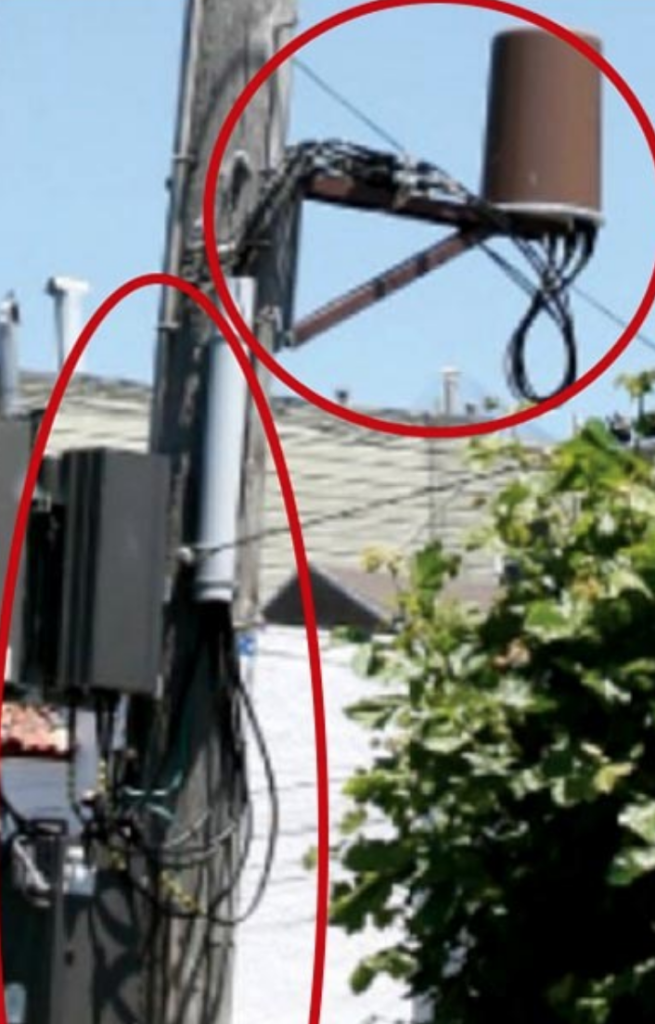
CA Bill SB 649 Would Force Transmitters Outside Your Home
Tell California State Senators: “NO” on SB 649- NO Small Cell Invasion
stopsmartmeters.org/2017/04/19/ca-bill-sb-649-would-force-transmitters-outside-your-home/
from http://scientists4wiredtech.com/2017/04/oppose-ca-sb-649/
San Francisco Small Cell Antennas
San Francisco – “bulky and noisy (cooling fans) Not so Small — Small Cell (Crown Castle for Verizon Wireless) about 15 feet from a home”
https://medium.com/@omarmasry/sb-649-challenges-legislative-pitfalls-a61a4427651a
••••••••••••••••••••••••••••••••••••••••••••••••••••••••••••••••••••••••••••••••••••••••••••••••••••••••••••••••••••••••••••••••••••••••••••••
New York
Oyster Bay supervisor vows town will limit cellphone antennas
Updated May 11, 2017 8:40 PM
Nassau, Oyster Bay, LONG ISLAND, NY
By David Olson
On Thursday, May 11, 2017, Oyster Bay Supervisor Joseph Saladino, speaking to a group of Woodbury residents who had just held a news conference to express frustration over cellphone repeaters installed in their neighborhood, said the town is drafting a new ordinance to limit the installation of cellphone repeaters and is exploring legal ways to get about two dozen repeaters removed from residents’ properties. (Credit: Newsday / Chuck Fadely)
Oyster Bay Supervisor Joseph Saladino on Thursday said the town is drafting a new ordinance to limit the installation of cellphone antennas and is exploring legal ways to get about two dozen of them removed from residents’ properties.
“We will make sure our voice is heard as we stand in lockstep with our residents to protect their rights and protect our communities,” Saladino said.
Saladino spoke on the street in front of a 30-foot-high antenna that was recently installed on the public right of way of Woodbury resident Denise Tufano’s front lawn. Tufano and others had held a news conference on the site to complain about the aesthetic, property-value and possible health effects of the antennas and urge the town to take action.
The antennas, part of the Verizon Wireless network, are called “small cells” and are installed closer to users to improve coverage, the company said in a statement.
Saladino found out about the news conference and, several minutes after it ended, arrived with other town officials to talk to reporters and residents.
One of the speakers and organizers of the news conference was Democratic supervisor candidate Dr. Marc Herman. Saladino, a Republican, and Herman accused each other of playing politics with the issue.
Herman said he was acting not as a candidate but as president of the Gates Ridge Civic Association in Woodbury. He asked why action hadn’t been taken earlier and why notice wasn’t given to residents of their installation.
Saladino, who took office Jan. 31, said he and town officials have been looking into residents’ complaints about the antennas for weeks. He announced at Tuesday’s board meeting that the town had rescinded seven permits for antennas.
Saladino said Thursday that the antennas should not be placed in residential neighborhoods and he urged the Federal Communications Commission to conduct radio-frequency testing near the devices, turn off any that are currently functioning, and study the health effects of antennas.
Deputy Town Attorney Matthew Rozea said a federal law limits municipal restrictions on cell phone equipment. Saladino called on Congress to change the law “to give local municipalities the right to determine where these go.”
Vicki Kramer, who has an antenna next to her Woodbury driveway, said she is worried about her two teenagers and other neighborhood kids, especially with the long-term health risks of the antennas not known.
Long Island, NY : Westchester Residents Concerned About Plans For New Cellphone Poles
December 7, 2016 11:11 PM
Filed Under: Cellphone Towers, Crown Castle Presentation, Huntington, Jennifer McLogan, Long Island, Lou Young, Rye, Suffolk County
RYE, N.Y. (CBSNewYork) — Towering poles topped with cellphone booster equipment are now lining the streets of some Westchester County and Long Island neighborhoods – and some are calling them an eyesore.
But as CBS2’s Lou Young reported, even more of the poles are expected to be installed.
The new cellphone equipment is invading Rye. Some towers already have been attached onto and above existing utility poles, and dozens in total are proposed in Rye alone.
Opponents fear it is just the start. “The 64 coming in would be Verizon nodes, but other carriers and infrastructure builders can come in and do exactly the same thing,” said Joshua Cohn of Rye. The mayor said the fact is that upgrades for cellphone networks are necessary.
“We all have (cellphones). We all use them,” said Rye Mayor Joe Sack. “And as a result, the wireless providers have to upgrade their network.” But while there are only 10 of the new units in Rye now, the sudden expansion proposal has stiffened opposition. Neighbors say they are not only big, but in the summer, internal cooling fans make them noisy as well.
“Walking the dog, I can hear it. It’s like a low whirring sound,” said Madeline Peron of Rye. Other communities are already reacting to the arrival of cellphone equipment. In Huntington, Long Island, 166 poles were recently approved and went up – much to the shock of those living nearby.
Jodi Abraham awoke this week to a new pole with a booster box and converters pointed right at her Huntington home. “This is new technology, we’re not sure, like most people we don’t know the health effects of it,” she told CBS2’s Jennifer McLogan. Her husband Peter wants nothing to do with the new installations. “I don’t want it on my property,” he said. “And I don’t want it adjacent to my property and my children.” The Abrahams and their neighbors claim no one with Town of Huntington alerted the community that it was entering an agreement with a giant telecommunications company. Peter demands to know how permits were passed and why residents weren’t previously told about it. A public hearing called Crown Castle Presentation was held in July. As CBS2’s McLogan reported, few in the community knew it was a company seeking to rent space on the poles to multiple cellphone providers.
The township claims they have limited authority, and the antennas pass government health and safety testing. Huntington town spokesman A.J. Carter tells CBS2 that Crown Castle told the town that the equipment is designed to fill in gaps in cell phone service. He claims the initiative is not a money making venture for the town.
CBS2 reports that Huntington stands to make about $230,000 in permit fees, along with 5 percent of future monthly gross revenue for 10 years for equipment placed in right-of-ways. “It feels like the town can do whatever it wants,” said Jodi.
Back in Rye, opponents are petitioning their city council to keep the cell equipment on public property and out of residential neighbourhoods. Mayor Sack insists the equipment is safe despite the lack of aesthetic appeal. “Telephone poles are not pretty objects, OK?” he said. “And when you put one of these antennas on top of one, they kind of blend in, you know, with the preexisting ugliness.”
Texas-based Crown Castle is trying to secure the utility pole leases for Westchester and Long Island, as well as for New York City. Multiple calls to the telecom company have not been returned.
WATCH VIDEO :
http://newyork.cbslocal.com/2016/12/07/cbs2-exclusive-li-residents-concerned-about-cell-phone-poles/
NewYork – CBSNewYork.com
Cell Phone Poles In Westchester County Causing Concerns
••••••••••••••••••••••••••••••••••••••••••••••••••••••••••••••••••••••••••••••••••••••••••••••••••••••••••••••••••••••••••••••••••••••••••••••
Kentucky
Small cell towers installed in right of ways irk neighbors, particularly in Clifton and Crescent Hill (UPDATE)
By JOE SONKA | October 28, 2015 1:59 pm Louisville, KY
A new 30-foot pole with cell antenna equipment installed in the right of way in Clifton
When Metro Council approved Fibertech Networks in 2014 as a franchisee to install cell antenna equipment for Verizon carriers, a company executive told council members they would put this on existing infrastructure and it would barely be noticeable by citizens.
However, a Fibertech executive told the Metro Council Public Works Committee in a special meeting Tuesday that because LG&E has not allowed them to put such equipment on existing poles, they have had to put new poles in neighborhoods’ right of ways — to the particular chagrin of residents in the Clifton and Crescent Hill neighborhoods.
Councilman Bill Hollander, D-9, who represents that area, said that neighbors and businesses have complained about several new 30-foot poles going up in front yards with no notice or explanation, saying they are an eyesore, block radio signals, and might present a health and safety concern.
While Metro Public Works project manager Al Andrews said these installations were permitted by the city’s franchise agreement and that door hangers were distributed giving information about the new small cell towers, Hollander indicated many of his constituents either did not get a hanger, or received one after it already was installed.
At Tuesday’s meeting, Hollander read a statement Fibertech gave to council last year saying the company would use existing infrastructure. In response, Joe Pellegrini of Fibertech said they had to change plans after LG&E said this equipment could not be attached to existing poles.
“That was earlier in the process when we definitely had hopes that LG&E would be amicable to us leasing space on their pole for the equipment to attach,” said Pellegrini. “That, unfortunately, did not come to fruition.”
Several council members wondered why LG&E made such a decision, and LG&E has not yet responded to Insider Louisville’s inquiries about this decision. Notices placed on the new small cell towers
Pellegrini said it has installed roughly 40 small cell towers with new poles, and it also submitted a document to the committee naming 57 proposed locations for more towers in its next phase. However, both he and Andrews indicated this phase would be delayed until they further discuss the concerns of Metro Council.
Hollander said there should be a review process in place for these new small cell towers before they expand across the city. “This phase will expand… If this continues, it will go countywide,” said Hollander. “I really think that we should take the appropriate steps to get some planning and design involved in this process. I hope we do that and there is this continued moratorium until we do that.”
Councilman Kelly Downard, R-16, also expressed concern that Fibertech is installing the small cell towers in a manner different than what was described to council members last year, and requested that the county attorney’s office look into whether the franchise agreement is being violated. Councilman Stuart Benson, R-20, expressed sympathy for Fibertech having to delay their installations to improve Verizon customer’s coverage, asking, “Do we need government involved in everything?”
Councilman Dan Johnson, D-21, said the towers were ugly and should at least include a street light, adding: “I would be really opposed to it if you put anything like that in my district.” Committee chairman Tom Owen, D-10, countered: “Well, I can assure you, Mr. Johnson, it’s a matter of time… do you use a lot of data?”
Hollander told IL on Wednesday that unless LG&E changes its policy or a review process is put in place, such small cell towers — often put in right of ways, as they must be far apart from existing poles on street corners — will proliferate unchecked around the city. He cited a recent Bloomberg article saying that due to increased demand for cell data, there will be 37 million small cell towers in America by 2017.
“These are just for Verizon,” said Hollander. “If another carrier decided they wanted small cell towers too, they could put one up too if they have a franchise with us… You could see this sort of thing proliferate.”
A small cell tower in Clifton
Hollander added that when the city and Metro Chief of Civic Innovation Ted Smith put out this request for proposal in 2013, in a response to not getting Google Fiber, “most of that was discussion of underground fiber. Nobody was envisioning towers on new 30-foot poles. Maybe Ted was, I don’t know, but I’m fairly confident council wasn’t.”
Asked about the apparent moratorium on installing small cell towers, mayoral spokesman Chris Poynter told IL there is no moratorium in place. Public Works spokesman Harold Adams also confirmed that a moratorium is not in place, though adding “we have asked Fibertech to pause further installations while we answer concerns raised by some citizens and proactively educate areas to be affected by the balance of installations.”
Hollander indicated to IL on Wednesday that a Clifton business owner — who had complained that a new cell tower in front of his store was jamming his equipment — was told by an electrician that it was being turned off this morning.
“In addition to having a franchise, they also need a permit, and I don’t believe Public Works should be issuing any new ones until information is shared with the public, questions are answered and a procedure for public notice is established,” said Hollander.
***** UPDATE 2:34 p.m. *****
LG&E spokeswoman Natasha Collins gave the following statement to IL, explaining why they would not allow Fibertech’s small-cell battery boxes to be on their poles:
“We participated in discussion with Fibertech regarding the potential for accommodating their equipment on our poles. As part of that discussion, we proposed to Fibertech terms and conditions applying the same standards we apply to other companies seeking to attach small-cell facilities. The standards we require of all small-cell attachers apply the National Electrical Safety Code requirements and LG&E construction standards that are necessary for the safety and reliability of our system.
While our standards accommodate cables, small-cell antennas, and equipment associated with the antennas, they do require small-cell battery boxes be on the ground instead of the pole because of the obstacle they present to crews attempting to safely climb poles and the threat to electric reliability presented by such large boxes attached to poles. Such boxes expose poles to increased wind and ice-loading. It appears that, as a result, Fibertech chose to install their own infrastructure to accommodate their equipment.
LG&E does not deny small-cell attachers access to our distribution facilities. LG&E will allow such attachments as long as the attacher abides by the reasonable terms and conditions and construction standards we apply to similar attachers as a group.”
Louisville, KY
••••••••••••••••••••••••••••••••••••••••••••••••••••••••••••••••••••••••••••••••••••••••••••••••••••••••••••••••••••••••••••••••••
OHIO
City of Cleveland Announces Lawsuit Opposing Ohio Senate Bill 331
The mayors and legal counsels for Cleveland and other cities in Ohio explain why they are challenging a recent law that allows telecom companies to put small/microcells anywhere they want, usurping the cities’ authorities. At about the 22 minute point, there is discussion about the interference that is caused by people living near these transmitters – people could experience worse service rather than better.
https://www.youtube.com/watch?v=JWE8EC-bqEI 36 minutes
DAS – Distributed Antenna System (12:20)
Co-teir Interference or Cross-teir Interference ( 22:40 ) which is general interference between all the small cell antennas
Co-Channel Interference ( 22:53 ) which is interference between channels on One cell
Hand Overs ( 23:10 ) which is the transferring from one cell to another
Ping-Ponging ( 23:23 ) confusion between the small cells
More than 80 towns and cities in Ohio have started legal action against the State Bill which would allow small/microcells to be placed and installed on public right of way without notification or regulation by the local government.
Cleveland is the only major city yet to join. The cost sharing of the legal costs has been set based on size of the community.
http://delgazette.com/news/53947/city-joins-litigation-against-state-law
“S&P Global Market Intelligence estimates that between 100,000 and 150,000 small cells will be constructed nationwide by the end of 2018, and that small cell deployments are expected to reach 455,000 by 2020 and nearly 800,000 by 2026.”
••••••••••••••••••••••••••••••••••••••••••••••••••••••••••••••••••••••••••••••••••••••••••••••••••••••••••••••••••••••••••••••••••
MINNESOTA
Telecommunications bill causes concern for local officials
By Katrina Styx on Apr 2, 2017 at 8:00 a.m.
Hastings representatives met with legislators to express their concerns over a small cell wireless bill making its way through the Legislature.
A bill moving its way through the Minnesota Legislature has local officials worried they might soon see their authority over public rights-of-way reduced.
As described by the League of Minnesota Cities, “The original bill would allow small cell wireless equipment to be placed on utility poles, signs, kiosks, traffic signals, light poles or arches without the ability of a city to adequately apply its zoning authority. Additionally, it prevents cities from negotiating rates, permit timelines and maintenance as it relates to the installation of emerging wireless infrastructure.”
The bill (HF 739) describes a “small wireless facility” as a wireless facility with an antenna inside an enclosure that is no larger than 6 cubic feet and with all other associated wireless equipment taking up a maximum of 28 cubic feet. The bill would authorize telecommunications companies to construct, maintain and operate small wireless facilities on existing support structures within the public right-of-way, and also stipulates that local governments must not require zoning approval for small wireless facilities in the public right-of-way.
The language has local leaders worried that, if approved, the bill would limit the city’s authority to regulate and manage local zoning. Hastings City Administrator Melanie Mesko Lee summed up her concerns in a letter to the mayor and City Council last week.
“The industry is pushing a nationwide agenda which would remove local authority to regulate access to our public rights-of-way,” she wrote. “Essentially, these unregulated providers would have unfettered access to this public asset. We do not object to the technology; we object to having our zoning and local control being taken away, especially for an unregulated industry.”
“This bill would significantly hinder a city, county or township from placing restrictions on the installation of new poles or the use of existing public utility poles (including light poles and signal poles) for small cell sites within our right-of-way,” she wrote later in the letter. “It also restricts our ability to recover costs and fees from the party that would use our poles for their equipment.”
Hastings officials have reached out to make sure their concerns are heard. Mayor Paul Hicks wrote letters to Rep. Tony Jurgens and Sen. Dan Schoen regarding his concerns about the legislation. Council members have also spoken up at the League of Minnesota Cities’ Legislative Conference for Cities. Additional letters to Jurgens and Schoen have been drafted, and the council plans to adopt a resolution at its April 3 meeting officially opposing the industry language in the bill.
The League of Minnesota Cities is also working to change the bill’s text. The league has suggested alternative language that “incorporates wireless providers into current law while retaining local decision-making,” according to a March 20 league article.
The Senate version of the bill (SF 561) has stalled, as it missed a critical deadline. However, the House version is still making progress, and late last week, it was added to an omnibus jobs and energy bill.
“This fight becomes more difficult now that the language has been added to an omnibus bill and has the potential to get lost in all of the other bills added to the larger bill,” Mesko Lee wrote.
During their visit with Schoen and Jurgens last week, Hastings representatives asked legislators to block the small cell wireless bill. They also asked for support for funding for roads and a bonding bill that would help fund repairs to Hastings City Hall.
••••••••••••••••••••••••••••••••••••••••••••••••••••••••••••••••••••••••••••••••••••••••••••••••••••••••••••••••••••••••••••••••••
Nebraska
Omaha, Nebraska – NBC WOWT
Micro Cellphone Antennas on Light Poles
Indianapolis – NBC WTHR
Small Cells in Butler-Tarkington neighborhood
••••••••••••••••••••••••••••••••••••••••••••••••••••••••••••••••••••••••••••••••••••••••••••••••••••••••••••••••••••••••••••••••••
Illinois
Chicago Small Cell Antennas
••••••••••••••••••••••••••••••••••••••••••••••••••••••••••••••••••••••••••••••••••••••••••••••••••••••••••••••••••••••••••••••••••••••••••••••
Maryland
Published on Nov 3, 2016
This is from a meeting in Montgomery County Maryland where 5 G is being forced on a community.
Hundreds Do Not Want Small Cell Towers Near Homes: Montgomery County
Published on Oct 27, 2016
Small cells emit radiation just like Wi-Fi. See the full October 26, 2016
Potomac, Maryland
••••••••••••••••••••••••••••••••••••••••••••••••••••••••••••••••••••••••••••••••••••••••••••••••••••••••••••••••••••••••••••••••••
Iowa
Small Cells in Des Moines IA – March 31, 2015
••••••••••••••••••••••••••••••••••••••••••••••••••••••••••••••••••••••••••••••••••••••••••••••••••••••••••••••••••••••••••••••••••
One hour talk about 5G Small Cells – how you can send your story about how they are effecting you or why you do not want these installed near your home.
People in CANADA can contact Industry Canada (ISED) before AUGUST 4th 2017
••••••••••••••••••••••••••••••••••••••••••••••••••••••••••••••••••••••••••••••••••••••••••••••••••••••••••••••••••••••••••••••••••••
Other Websites about 5G & The INTERNET OF THINGS (IoT)
Scientists4wiredtech.com/what-are-4g-5g/
https://kpfa.org/episode/your-own-health-and-fitness-july-18-2017/
Small Cells, Micro Cells, Macro Cells, eNodeB, eNB, oDAS (outdoor distributed antenna system), DAS (distributed antenna system) 5G, Internet of Things IoT
According to a CBS Sacramento report, Verizon 5G is not active in some areas said to be 5G. CBS provides images of Small Cells for 5G in Sacramento, similar to those in Vancouver , Calgary , Toronto and Montreal .











Verizon 5G small cell antenna on top of a light pole
••••••••••••••••••••••••••••••••••••••••••••••••••••••••••••••••••••••••••••••••••••••••••••••••••••••••••••••••••••••••••••••••••••
California • Florida • Kentucky • Maryland • Michigan • Minnesota • Missouri • North Carolina • New Mexico • New York •
Ohio • New Jersey • Louisiana • Texas • Rhode Island • Iowa
#BILLS #SB649 #SB331 #S19 #Bill C-648 #S3157
